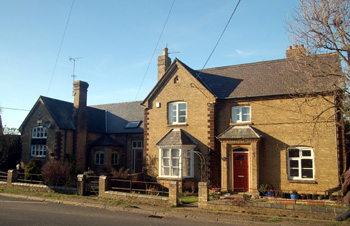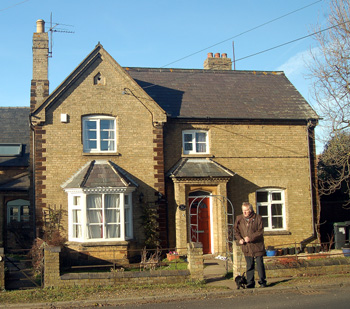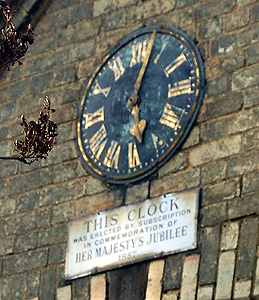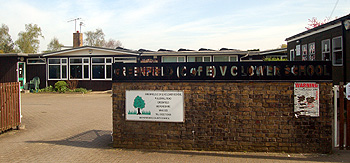Greenfield School
![Greenfield School about 1900 [Z50-49-1]](/CommunityHistories/Greenfield/GreenfieldImages/Greenfield School about 1900 [Z50-49-1].jpg)
Greenfield School about 1900 [ref: Z50/49/1]
The first Education Act was passed in 1870 (more correctly it was known as the Elementary Education Act). It was a milestone in the provision of education in Britain demonstrating central government's unequivocal support for education of all classes across the country. It also sought to secularise education by allowing the creation of School Boards. These were groups of representatives, elected by the local ratepayers and the Board had the powers to raise funds to form a local rate to support local education, build and run schools, pay the fees of the poorest children, make local school attendance compulsory between the ages of 5 and 13 and could even support local church schools, though in practice they replaced them, turning them into Board run schools (known as Board Schools). Naturally, and luckily for local historians, the Act required a questionnaire of local schools in 1870. The return for Flitton states that Greenfield Church of England School accommodated a hundred juniors and twenty five infants.
This school seems to have been set up in 1869 but not officially opened until 1870. It is not mentioned in The Post Office Directory for 1869, which was probably largely compiled in late 1868. The school logbook [ref: SDFlitton1] begins on 3rd January 1870 with the following entry: "The School was re-opened after a fortnight's holiday. In the absence of a Mistress the Rev. John Storr, the clergyman in charge of Greenfield, superintended and carried on the work of the School with the aid of the assistant teacher Mary Fennemore and Monitors". The next entry, 6th January, reads: "Miss Eliza Thompson of LincolnTrainingCollege arrived and forthwith assumed her duties".
The logbook records the sizes of the classrooms. The main school room was 38 feet long by 20 feet 4 inches broad by 19 feet high. A classroom measured 14 feet 4 inches by 12 feet by 19 feet. The infants' classroom measured 22 feet 3 inches by 20 feet 4 inches by 19 feet [ref: SDFlitton1].
On 6th July 1870 an inspector visited and his report is copied in the logbook [SDFlitton1]: "The commencement of this school is very encouraging and it is to be hoped that the Managers will be able to provide a staff sufficient for the due instruction of such a large number of children".
"A literal adherence to the Ninth Supplementary Rule will be expected in future".
"As the Evening School was open 30 times under the Certificated Mistress, a Grant for nine months has been allowed on account of it. The rest of the Grant is limited by Article 51(b)".
"Annie Godfrey's attainments do not, at present, reach the Standard prescribed for the office of Pupil Teacher".
![Greenfield schoolchildren about 1900 [Z50-142-46]](/CommunityHistories/Greenfield/GreenfieldImages/Greenfield schoolchildren about 1900 [Z50-142-46].jpg)
Greenfield schoolchildren about 1900 [ref: Z50/142/46]
The schedule for 1873, copied in the logbook, gives the names of ninety two children, when they were admitted and their age. The earliest admission is January 1870. A list can be found elsewhere.
A land mark Education Act was passed in 1902, coming into effect in 1903. It disbanded the School Boards and gave day to day running of education to newly formed Local Education Authorities, usually the county council, as in Bedfordshire. The old Board Schools thus became Council Schools whilst the old National, British and other non-Board schools became known as Public Elementary Schools. As a church school, Greenfield became a public elementary school.
Bedfordshire Archives has a scrapbook of cuttings of visits made to most Bedfordshire Schools by School Inspectors for a period from just before the First World War through the inter-war years [ref: E/IN1/1]. The first report dates from 1911 when average attendance was 70: "This school well maintains its reputation for vigorous, careful and intelligent instruction. Both order and tone are excellent; good progress is made in all Classes and the level of efficiency reached is most creditable to the joint Head Teachers in charge".
The next visit was in March 1914: "This school continues to be carefully and well taught and order and tone are admirable. The instruction bears the stamp of care and intelligence and the condition of the school reflects much credit upon the joint head teachers".
The next visits were in September 1921 and May 1922 and the inspector reported as follows: "The school was visited on an extremely hot day and the response of the children was almost certainly adversely affected. The Infants' Class has for some time been under the care of very weak Teachers, and the present Teacher, who is improving, had but little experience before taking up her duties here a year ago. Still, noticeable progress has been made in the interval between the two visits of inspection. The children have not grasped the correct sounds of the letters, and to very simple, but strange, tests are very slow. They did well in their Wordbuilding from a very formal book. Standard I also are slow except in Wordbuilding, and the Infants and this newly promoted group are poor in speech. It is much to the credit of if the Teacher of Standards I and II that except as regards the aspirate, which is usually misplaced, the speech and expression in Reading and Recitation is so much better in Standard II. The Singing is good, and was well rewarded at the Eisteddfod" [a music festival briefly introduced by Bedfordshire County Council between the wars, copied from the Welsh concept] "Physical Exercises, too, are good and there is an interesting attempt at self government. Arithmetic is not a strong subject in the top group; Handwriting and Composition are hardly as good as in neighbouring schools similar in size and proximity to the town. Useful Gardening and Needlework is done; rather more complete records of work in Gardening by the children, and in the Record Books by the Head Teacher are desirable. On the whole the School is doing well". The very hot day had one further ramification, as an additional note describe, regarding the toilets, in those days called offices, "The Offices smelt offensively on 22nd May 1922. If, as I am informed, almost two years have elapsed since they were limewashed, this would partly account for it".
The next visit was in May 1925, when average attendance was 85. "In this school too little progress is made in the Infants' Class, especially in Reading. As a consequence, the Reading of Standards I and II, especially that of Standard I, is below the average, though the Teacher works well. In the Upper Group (Standards III-VII) Arithmetic is weak except in Standard V. Handwriting and Composition have improved to some extent, but they should further improve. The rest of the work of this group is good, and Physical Training and Singing are much above the average. Many of the Reading Books are in a dilapidated condition, and need replacing".
The Rating and Valuation Act 1925 specified that every building and piece of land in the country was to be assessed to determine its rateable value. Greenfield, like most of Bedfordshire, was assessed in 1927 and the valuer visiting the schoolhouse found it occupied by Mrs. Leach who paid rent of £14 per annum to the trustees. Accommodation comprised two reception rooms, a kitchen, a scullery, four bedrooms and a box room.
Accommodation comprised a kitchen, a parlour and a scullery with a small pantry. Three bedrooms lay upstairs. There was also a "small porch". A brick and slate privy and coal shed stood outside along with a weather-boarded and corrugated iron wood shed. The valuer commented: "Nice house".
In October 1928 the inspector reported as follows. "The recreational and aesthetic side of the work of this school is stronger than the fundamental and ordinary side though the latter is not bad. Throughout the school the children speak correctly without affectation but with a polish not often found in country schools. The singing of the highest class is much above average. The tone is pure and the words carefully enunciated. A sight test in two parts was correctly rendered first time. Physical exercises in this class are also well done and this must be the result of regular practice. Nature Study out of school is strongly fostered".
"Tests were given to the highest class in these subjects. That in Composition was fairly good in vocabulary, generally accurate in expression but the full stop was omitted too frequently. The test in Arithmetic showed a decided weakness but that in silent Reading showed good results in Standards VI and VII. Response in Geography and History is only moderate".
"The work of the middle class is fairly good. It is in need of broader treatment in all subjects. Greater variety would help the children to reason better and to form opinions and would lay a better foundation for the work of the highest class".
"The Infants' section is carefully taught and here the Speech is carefully trained".
"The behaviour of the children leaves nothing to be desired and there is little doubt that the training mentioned in the early part of this report reacts for the good of these children and is responsible for the happy and healthy tone that exists".
In 1932 application was made for the formation of a branch county library at the school [ref: LiV10]. To judge by the inspection report of 1956 (see below), this application was successful.
The final report in the scrapbook was made in September 1933, when average attendance was 76. "The Head Mistress has had charge of this school for two years. Her approach to work is enlightened, and her influence in the habits, manners and industry of the children is very marked. Most of the teaching in her own class if characterised by a vitality and an enthusiasm which foster a healthy school spirit, and make an acceptable standard of work easier to reach. Physical Training and Singing are worthy of special commendation".
"The middle group is now taught by a mistress who promises to adapt herself readily to the work; and the children are making very fair headway in all branches of the instruction".
"The Infants' Class is taught under unusually cramped conditions; but the teacher in charge is of a cheerful disposition and is able to get the most of the children on quite well in the main subjects. Natural free movement and most of the more suitable activities which can be encouraged in a well equipped Infants' room are impossible here; and in consequence the course of training is unduly narrow".

The Old School and School House, February 2011
The third of the great Education Acts was that of 1944 which established the principle of County Primary Schools for children up to the age of 11, at which time they took an examination to determine the nature of the secondary school they would attend until they were 15, the most academically able going to grammar schools, the rest to secondary or secondary modern schools. The act also created two types of successor to the public elementary schools - the Voluntary Aided and Voluntary Controlled schools. Voluntary Aided schools are those in which the Local Education Authority funds the school but the governing body is independent, they are usually Anglican or Roman Catholic schools. Voluntary Controlled schools own their own buildings whilst the staff are employed directly by the governors.
About the end of World War Two a report was produced for the school managers [ref: P12/29/2]. It began: The Education Act, 1944, requires that every Local Education Authority shall provide secondary school education for all children over eleven years of age and that this secondary education shall be provided in a building which is distinct and apart from the building in which primary school children (i. e. children between the ages of five and eleven years of age) are educated".
"This means that in the case of Greenfield school where children from five to fourteen years of age are at present being educated a division will have to be made and some further provision set up". The Diocesan Committee on Education recommended that Greenfield continued as a primary school only and "that a new school for secondary school children will have to be built somewhere in the vicinity". Around this time there was an appeal from some of the residents for school "free of all sectarian influences" [ref: P12/29/3]. In 1949 one of the residents, later a churchwarden of Flitton and member of the parish council, wrote to the Vicar of Flitton that quite large numbers of children from Greenfield were being sent to other schools, such as Maulden [ref: P12/29/3]. He asked why: "fully expecting to be told in no uncertain terms that the parents' objection to the sectarian nature of religious education which Church Schools are entitled to offer. I was surprised therefore to e told by the five or six parents present who were concerned that, shortly "they don't teach them anything at Greenfield". He found himself in the school a short time later during a parish council meeting and "amused myself by glancing through the class-books of a pupil in whose desk I happened to sit". He then criticised the things he found as follows:
"1. The spelling of this pupil (whom I believe to be about fourteen) is beyond belief, e. g. pasels (for parcels), leff (for leaf), a crost (for across), finist (for finished), becous (for because).
2. The "composition" was so poor that it is clear no reasonable amount of simple reading has ever been done.
3. In a new excercise [sic] book for arithmetic, all six problems worked were incorrect.
4. Apart from the arithmetic, there was absolutely no evidence of any marking in the books.
5. An undue proportion of time seemed to have been spent in water-painting".
In 1955 the Sites and Buildings Sub-Committee of the Bedfordshire County Council Education Committee [ref: EM37] noted: "The estimated cost of bringing the existing school buildings up to a reasonable standard is £9,190 and that of providing a new school on another site id £10,439". It was, therefore, resolved: "That the architect prepare a scheme for thwe provision of a new school and institute negotiations for the acquisition of a new site".
In 1956 a school inspector's report for Greenfield [ref: P12/29/5] read: "Three events affecting this School have happened since the issue of the last report in 1950; the senior children [i.e. those aged over eleven – see above] now attend Redborne Secondary School, the juniors and infants from Pulloxhill were admitted when the village school was closed in 1951, and [Voluntary] Controlled Status [see above] was granted in 1954. By 1954, the premises were in a dilapidated condition; since then, the main building and offices have been renovated so that the rooms now present a colourful appearance. The roof of the infants' room is supported by vertical beams, the 39 children have little space to move in the playgrounds owing to the restricted site and only one wash bowl on a stand in the infants' room is available, but even this is better than the inaccessible sink in the coal shed. For some time, however, consideration has been given to the erection of new schools to serve the villages of Greenfield and Pulloxhill but the acquisition of suitable sites has not been an easy matter".
"No provision is made to serve mid-day meals; consequently, very young children have to travel, mainly on foot, a journey of 1½ miles or more, four times a day. A small room is available that could be adapted for scullery purposes and so meet an obvious case of necessity".
"The Head Mistress, who came here eleven years ago, is steadily adapting herself to the changed conditions and conducts a happy School. The 19 children in her class are introduced to a number of interests of cultural value; their tuneful singing is pleasing, their creative efforts in art and handwork show good taste and skill, and they make good use of the County Library [see above]. It is in oral and written English that improvement might be expected. Given clear objectives, that need to be defined in the syllabuses as a whole, it is highly probable that the progress of many of the children could be accelerated".
"The 20 infants are taught by a Mistress, of sympathetic ideals, who has returned to teaching in this School after retiring in 1955".
Finally, in 1960, Greenfield got its new school. At that date the site, in Pulloxhill Road, lay in the parish of Pulloxhill. This continued until a boundary change in 1984 put Greenfield School into the new civil parish of Flitton and Greenfield. The 1.375 acre site was acquired by Bedfordshire County Council from the personal representatives of George Vincent, deceased, for £1,000 on 17th April 1959 [ref: CCE1285/5]. The new school was officially opened by the Bishop of Bedford on 28th June 1960 [ref: P12/29/6-7].

The Old School House February 2011
Following the school's move the old school was valued [ref: P12/29/8]. The valuer commented: "This is a somewhat difficult property to value having regard to the various possible uses to which the Old School could be put and whether Planning Permission would be forthcoming … We are of opinion that the present day market value of the whole property with vacant possession is the sum of two thousand pounds and we recommend that the asking price be fixed at three thousand pounds". At the time of writing the old school and school house form dwellings – the clock, erected by public subscription to mark Queen Victoria's Golden Jubilee in 1887, is still on the school wall.

The old school clock February 2011
In the 1970s Bedfordshire County Council introduced comprehensive education, doing away with the 11+ examination and grammar schools and introducing a tier of school between the old County Primary and County Secondary Schools. Thus Lower Schools now taught children aged 4 to 9, Middle Schools from 9 to 13 and Upper Schools from 13 onwards. Greenfield thus became a Voluntary Controlled Lower School, which it remains at the time of writing [2011]. The school buildings were extended in the late 1970s [ref: CA2/866].
At the time of writing the Pulloxhill and Greenfield Federation sees Greenfield Lower School working very closely with Pulloxhill Lower School. On 1st April 2009 Bedfordshire County Council was abolished and two new unitary councils carved out of the dead carcase. The new Local Education Authority for Greenfield School is Central Bedfordshire Council.

Greenfield Lower School April 2011